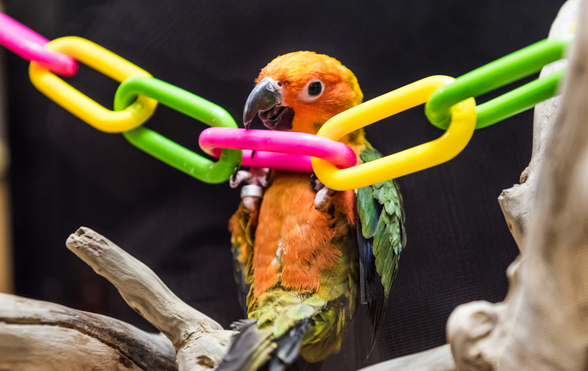Wanting to upcycle or simply save money and make your own parrot toys? Parrot expert, Dorothy Schwarz top 10 list gives you ideas on what you can make, and how.
Get a quote to insure your parrot for £5,000 or £2,500 of vet fees, death and theft | Death and theft cover only also available | 94% of pet insurance claims paid in 2019 | Pay over 10 months by (0% APR) Direct Debit | Read our customer reviews on Feefo
Wire coat hanger climbing frame | Ropes in house, aviary and bird room | Homemade foraging toys | A Willow Wreath | Homemade swings | Flowers | Foliage | Charity Shops | Cardboard boxes | Books | Toy-shy birds
Parrots are incredibly intelligent creatures and therefore require mental stimulation in order to keep entertained. As much as many of us wish we could spend all our time with our pets, we know this simply isn’t realistic.
Keeping captive birds happy and entertained means they’re less likely to develop unwanted behaviours like plucking, screaming or repetitive movements.
Own a cat or dog? Get pet insurance that covers up to £15,000 in vet fees every year, including dental for illness and accidents with British Pet Insurance.
Unfortunately, most parrots’ normal way of playing is to chew to bits any favourite item which can quickly become costly.
However, using a little ingenuity, you can make a number of different DIY parrot toys, constructed from household items and from the natural world at very little cost.
This is also a great way to own pets in a more sustainable way as many of these ideas include upcycling every day household items or items you can find in your garden.
Here are ten of my favourite homemade parrot toys, and there are many more. The only limit is your imagination and taking reasonable safety precautions.
1. Wire coat hanger climbing frame
This works better hanging from a hook in a room. Many cages are not large enough. You need a hook in the ceiling. Three coat hangers, tied one below the other. Tie some treats or chew objects to the bottom of each hanger and there you go.
Toys for parrots can provide entertainment in a number of ways. Hanging parrot toys such as this one are a great option as they encourage climbing but also provides treats or chew opportunities dependant on how you dress the hangers.
2. Ropes in house, aviary and bird room
We keep hooks screwed into the picture rails of our rooms where the birds have access in their out of cage time. Ropes are attached at either end.
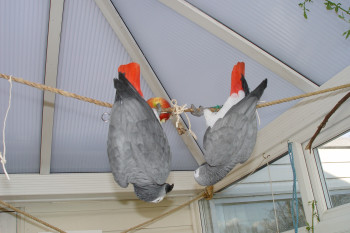
We unhook them when entertaining non-parrot people.
Our current four indoor pet parrots will spend hours on their ropes playing and swinging and provide a sure way for me to know when they are tired; they remain motionless.
I also use ropes in the aviary. One of them is a ship’s rope which was here when we arrived in 1984.
A warning: with any ropes please inspect daily for frayed ends because a bird can get its feet trapped or even its neck.
Enjoying this article? You may like to read: How and why do parrots talk? How to teach your parrot to talk
3. Homemade foraging toys for parrots
Wrap a treat or a toy in raffia mat and hang it in the cage. You can use the leaves from safe plants or pine cones, small boxes like tablet boxes(make sure they’re empty and don’t contain tablets) and many other household items are suitable.
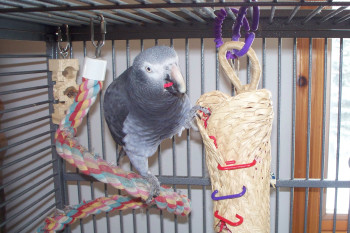
Like toddlers with Christmas gifts, parrots often prefer the wrapping to the toy or treat inside.
Balsa wood foraging toys are sold and are costly but parrots love prising a nut out of the soft wood. You can sometimes buy balsa wood in a craft shop.
4. A Willow Wreath
Make a circle with stiff wire and make sure the ends are securely tied. You can also use a hula hoop if there is enough space to hang it.
You need between 20 and 50 sprays of willow, soft bedable ones from 30 cm to 2 m are easy to thread.

You can strip off the leaves or leave them on. Simply wind the willow sprays onto the wire circle or hoop.
It is a relaxing activity to do and takes me about 40 minutes. Tie the ends in with thin wire.
The next day the wire twists can be untwisted; the willow fronds keep their shape.
From the completed wreath, you can hang food treats or flowers or small toys.
When I make one with roses it takes less than the 40 minutes I took making it, for the birds to strip and eat the flowers.
The willow wreath itself lasts longer up to three months if I have woven a lot of strands into it. I make smaller hoops for cages.
Find out what plants you can use for making toys: Safe food and plants list for parrots
5. Homemade swings
A broom handle will provide at least two swings. Use rope, chain or plastic chain from the hardware store.
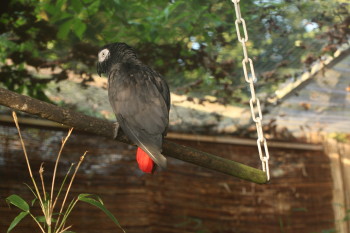
Tyres with the inner tube removed make splendid aviary swings. Birds love swinging. Wild birds swing in the trees and this behaviour is a natural one for our parrots.
6. Flowers
Birds love chomping flowers. Many wild birds live off them. If you are not using flowers from your garden, it is advisable to wash shop flowers thoroughly in case there was preservative or insecticide on them.
Some flowers are poisonous like datura, foxgloves and laburnham. Poinsettia and holly are advised against. If you have several birds you will find out which flower is their favourite.
7.Foliage
We live in semi- rural Essex with a large garden so cut branches, dandelions, willows, acorns, etc. present no hazards from insecticides or exhaust fumes.
These provide a great option for use as toys in parrots cages as they provide security and shelter.
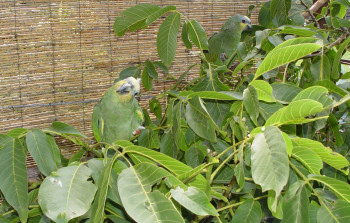
In aviaries, shy birds are clearly happier to have screens of foliage to hide amongst.
For city dwellers all I can suggest is cultivating your country cousins or striking up a relationship with the gardeners or rangers in your local park.
They will often give you cut branches or not object to you gathering dandelions or picking up fir cones.
We’d always recommend cleaning any plants before giving them to your parrot. A quick dip in a parrot suitable disinfectant is a solution. F 10, grapefruit seed extract, or plain soapy water, well rinsed provides a solution.
Don’t use bleach or household cleaners to disinfect toys for birds.
Birds love branches. Disinfect them if you are worried about insects or herbicides. Driftwood from the beach makes attractive perches or toys.
8. Charity Shops
If you’re trying to be more sustainable by buying second hand, or looking to source cheap parrot toys, charity shops can be a good option.
Although not home made – most rattles, wooden and soft toys are manufactured as hygienic for babies so I guess they should not harm parrots. Charity shop toys can save you valuable pennies when your looking for parrot toy ideas.
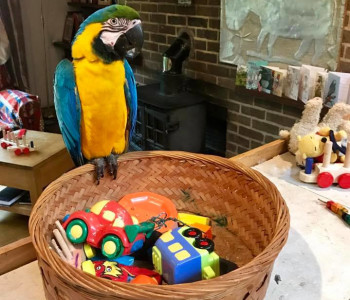
I avoid toys with tiny parts but I will accept anything made of wood.
Some owners consider the stuffing is dangerous and don’t use soft toys. I do but throw them away when they are ripped and the stuffing is coming out.
If you have a particularly destructive bird, it’s best to avoid giving them soft toys. If you’re ever in doubt or want further advice, consult with your vet.
Young birds will often enjoy snuggling up to a soft toy which I guess reminds them of their faraway nest mates.
If you want to be super cautious, don’t buy anything that does not have a safety label attached.
9. Cardboard boxes
These make superb toys. It is not recommended to leave boxes around with birds who are in a nesting mood.
When they aren’t, my birds adore playing in boxes. On top of the macaw cage, I have a little hamlet of various sized boxes. My four pet birds take turns at hiding in them and chewing them. With internet shopping, most of us have a ready supply of cartons.
10. Books
I‘m not suggesting you let the birds loose with your first editions. Old telephone directories or shopping catalogues hung in a cage will provide many happy for hours of shredding.
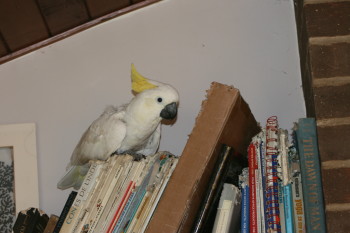
I have taught my birds the ‘Off’ command, so they will leave the bookshelves alone (with some prompting).
Lily cockatoo’s passion for making confetti out of books was satisfied by allowing her a special place on a high bookshelf with unwanted books (poor things) that she shredded for hours.
She actually dug a hole in a row of old books. She did not allow the other birds to venture on to her shelf. The downside for me was sweeping up a pile of confetti each morning.
Toy-shy birds
Wanting to encourage your parrot into playing with toys? Some pet birds, through not being familiarised with toys as young birds are frightened of anything strange.
African Greys have a reputation for this. Undeserved because young Africans Greys learn to play with toys as readily as other species.
This aversion can be overcome with patience. Leave the toy in the bird’s sight whilst they are in their cage. Watch their body language. They will show when the object is too near for comfort. Move it nearer each day. Eventually most birds will accept the strange object. Just do not rush.
Play with the toy yourself in their sight. When they are on your hand, show it to them.
To desensitise a phobic bird can take from a few days to much longer but with patience, the majority of birds will accept a toy.
And finally, of course you know that your bird’s favourite toy is yourself.
The right type of toy for the right parrot?
The above gives a comprehensive overview of 10 DIY parrot toys.
When it comes to specific breeds such as toys for Indian Ringneck parrots, macaw parrot toys or the best African Grey parrot toys, different parrots and different breeds have different personalities and preferences.
As you get to know your parrot, their personality and what they like, you’ll soon start to understand what type of parrot toy they engage with most.
Some parrots will prefer natural parrot toys made our of natural materials whereas some may prefer foraging toys or toys which enable them to climb.
If you don’t fancy creating any toys yourself, both online and in store pet shops sell a variety of toys for your parrot, with specialist parrot retailers having an even wider range of options.
If you don’t fancy creating any toys yourself, why not take a look at Northern Parrots? They sell a range of toys that will entertain your bird.
Insure your parrot for £5,000 or £2,500 of vet fees, death and theft | Death and theft cover only also available | 94% of pet insurance claims paid in 2019 | Pay over 10 months by (0% APR) Direct Debit | Read our customer reviews on Feefo.
Alternatively you can call us on 0345 982 5505

